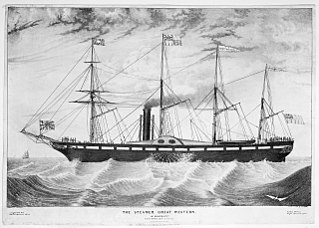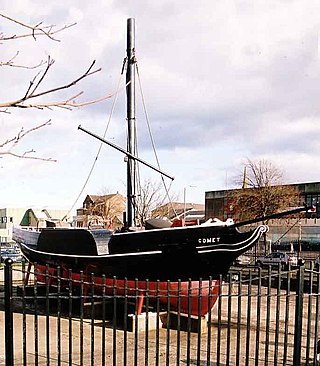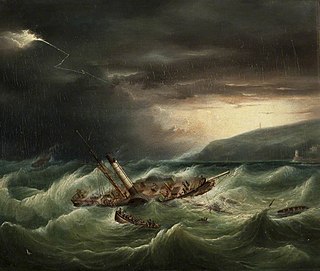
A steamship, often referred to as a steamer, is a type of steam-powered vessel, typically ocean-faring and seaworthy, that is propelled by one or more steam engines that typically move (turn) propellers or paddlewheels. The first steamships came into practical usage during the early 1800s; however, there were exceptions that came before. Steamships usually use the prefix designations of "PS" for paddle steamer or "SS" for screw steamer. As paddle steamers became less common, "SS" is incorrectly assumed by many to stand for "steamship". Ships powered by internal combustion engines use a prefix such as "MV" for motor vessel, so it is not correct to use "SS" for most modern vessels.

A steamboat is a boat that is propelled primarily by steam power, typically driving propellers or paddlewheels. Steamboats sometimes use the prefix designation SS, S.S. or S/S or PS ; however, these designations are most often used for steamships.

A paddle steamer is a steamship or steamboat powered by a steam engine that drives paddle wheels to propel the craft through the water. In antiquity, paddle wheelers followed the development of poles, oars and sails, where the first uses were wheelers driven by animals or humans.

SS Great Western of 1838, was a wooden-hulled paddle-wheel steamship with four masts, the first steamship purpose-built for crossing the Atlantic, and the initial unit of the Great Western Steamship Company. She was the largest passenger ship in the world from 1837 to 1839, the year the SS British Queen went into service.

PS Waverley is the last seagoing passenger-carrying paddle steamer in the world. Built in 1946, she sailed from Craigendoran on the Firth of Clyde to Arrochar on Loch Long until 1973. Bought by the Paddle Steamer Preservation Society (PSPS), she has been restored to her 1947 appearance and now operates passenger excursions around the British coast.

The PSComet was built in 1812 for Henry Bell, a Scottish engineer who with his wife had become proprietor of the Baths Hotel offering sea bathing in Helensburgh. On 15 August 1812, Bell's ship began a passenger service on the River Clyde, connecting Helensburgh to Greenock and Glasgow. This was the first commercially successful steamboat service in Europe. Bell obtained the engine from John Robertson of Glasgow, and the ship was built for him by John and Charles Wood of Port Glasgow.

The Pacific Mail Steamship Company was founded April 18, 1848, as a joint stock company under the laws of the State of New York by a group of New York City merchants. Incorporators included William H. Aspinwall, Edwin Bartlett, Henry Chauncey, Mr. Alsop, G.G. Howland and S.S. Howland.
The West Cornwall Steam Ship Company was established in 1870 to operate ferry services between Penzance, Cornwall, and the Isles of Scilly. It became the West Cornwall Steamship Company in 1907 and was wound up in 1917.

SS City of Everett was an important whaleback steamship. She sailed from 1894 until 1923, and was the first U.S. steamship to pass through the Suez Canal, as well as the first to circumnavigate the globe. Her radio call letters were GF and her signal letters KMCQ.

PS Portland was a large side-wheel paddle steamer, an ocean-going steamship with side-mounted paddlewheels. She was built in 1889 for passenger service between Boston, Massachusetts, and Portland, Maine. She is best known as the namesake of the infamous Portland Gale of 1898, a massive blizzard that struck coastal New England, claiming the lives of over 400 people and more than 150 vessels.
SS Comet may also refer to one of several commercial passenger steamships:
Teutonia was a screw steamer that was built by Caird & Company, Greenock, Renfrewshire, Scotland for the Hamburg Brazilianische Packetschiffahrt Gesellschaft in 1856. It later served with the Hamburg Amerika Line before being sold to British owners in 1877 and Italian owners in 1884, serving them under the names Regina, Piemontese, Città di Savona and Mentana The ship was scrapped in 1894.
PS Admiral Moorsom was a passenger paddle steamer operated by the London and North Western Railway (LNWR) from 1860 to 1885.

Castalia[Note A] was a 1,533 GRT twin-hulled paddle steamer that was built in 1874 by the Thames Ironworks and Shipbuilding Company, Leamouth, London for the English Channel Steamship Company. She was acquired by the London, Chatham and Dover Railway (LCDR) in 1878 but had already been laid up by then and was not operated by the LCDR. In 1883, she was sold to the Metropolitan Asylums Board and converted to a hospital ship. She served until 1904 and was scrapped in 1905.

PS (RMS) Prince of Wales No. 93381 was a steel built paddle steamer which was purchased together with her sister PS Queen Victoria, by the Isle of Man Steam Packet Company from the Isle of Man, Liverpool and Manchester Steamship Company in 1888 - referred to as The Manx Line.

SS Arctic, an American paddle steamer owned by the Collins Line, sank on September 27, 1854, 50 miles (80 km) off the coast of Newfoundland after a collision with SS Vesta, a much smaller French vessel. Passenger and crew lists indicate that there were probably more than 400 on board; of these, only 88 survived, most of whom were members of the crew. All the women and children on board perished.
The PS Connaught was a 380-foot-long (120 m) passenger sail and steamship which was built in 1860, and sank on its maiden cruise. It initially sailed from Galway, Ireland to St John's, Newfoundland, and thereafter sailed on to Boston, Massachusetts. But the ship foundered in October 1860 in a storm off approximately 100 nautical miles (190 km) from Boston. Although all of the lifeboats were smashed in the storm, all of the passengers and crew aboard were saved by the heroic actions of a fruit transport ship, the Minni Schiffer, and her Captain, John Wilson.

The first RMS St Patrick of the St. George Steam Packet Company was a wooden paddle steamer, launched by Mottershead & Hayes of Liverpool on 22 April 1822 for passenger service. The ship first served on the line's Dublin to Liverpool route, with a stopover in Bristol. The ship was sold in 1824 to Portuguese interests and renamed the ship Restaurador Lusitano, which operated on the Lisbon to Oporto route. Civil war broke out in 1828 and the vessel was chartered for service by the Absolutists in 1832. While sailing with troops and supplies, Restaurador Lusitano was severely damaged in a storm while attempting to aid another vessel in trouble. The damage was too much and Restaurador Lusitano sank on 11 September 1832.












